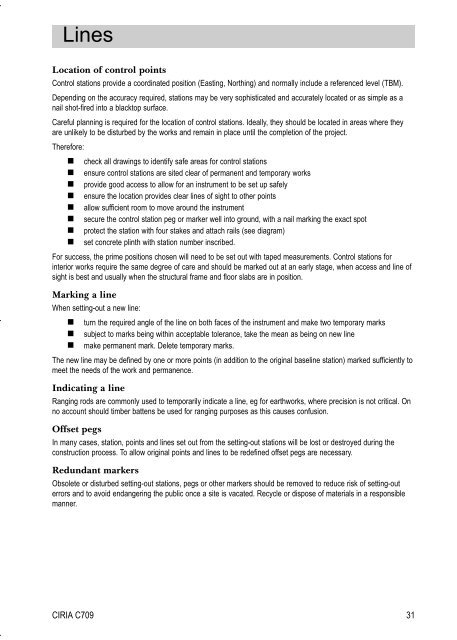Download - Engineering Surveyor
Download - Engineering Surveyor
Download - Engineering Surveyor
- No tags were found...
You also want an ePaper? Increase the reach of your titles
YUMPU automatically turns print PDFs into web optimized ePapers that Google loves.
LinesLocation of control pointsControl stations provide a coordinated position (Easting, Northing) and normally include a referenced level (TBM).Depending on the accuracy required, stations may be very sophisticated and accurately located or as simple as anail shot-fired into a blacktop surface.Careful planning is required for the location of control stations. Ideally, they should be located in areas where theyare unlikely to be disturbed by the works and remain in place until the completion of the project.Therefore: check all drawings to identify safe areas for control stations ensure control stations are sited clear of permanent and temporary works provide good access to allow for an instrument to be set up safely ensure the location provides clear lines of sight to other points allow sufficient room to move around the instrument secure the control station peg or marker well into ground, with a nail marking the exact spot protect the station with four stakes and attach rails (see diagram) set concrete plinth with station number inscribed.For success, the prime positions chosen will need to be set out with taped measurements. Control stations forinterior works require the same degree of care and should be marked out at an early stage, when access and line ofsight is best and usually when the structural frame and floor slabs are in position.Marking a lineWhen setting-out a new line: turn the required angle of the line on both faces of the instrument and make two temporary marks subject to marks being within acceptable tolerance, take the mean as being on new line make permanent mark. Delete temporary marks.The new line may be defined by one or more points (in addition to the original baseline station) marked sufficiently tomeet the needs of the work and permanence.Indicating a lineRanging rods are commonly used to temporarily indicate a line, eg for earthworks, where precision is not critical. Onno account should timber battens be used for ranging purposes as this causes confusion.Offset pegsIn many cases, station, points and lines set out from the setting-out stations will be lost or destroyed during theconstruction process. To allow original points and lines to be redefined offset pegs are necessary.Redundant markersObsolete or disturbed setting-out stations, pegs or other markers should be removed to reduce risk of setting-outerrors and to avoid endangering the public once a site is vacated. Recycle or dispose of materials in a responsiblemanner.CIRIA C70931
















